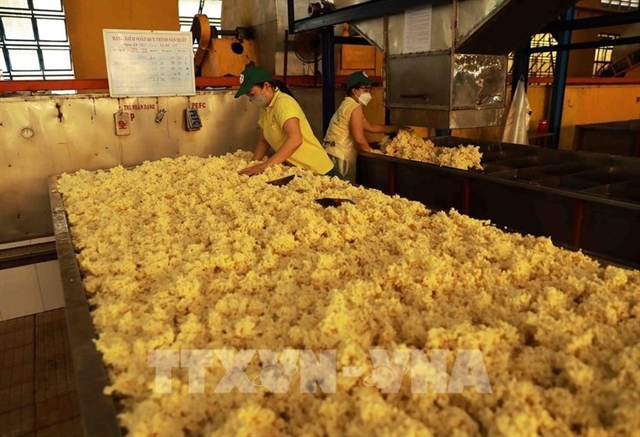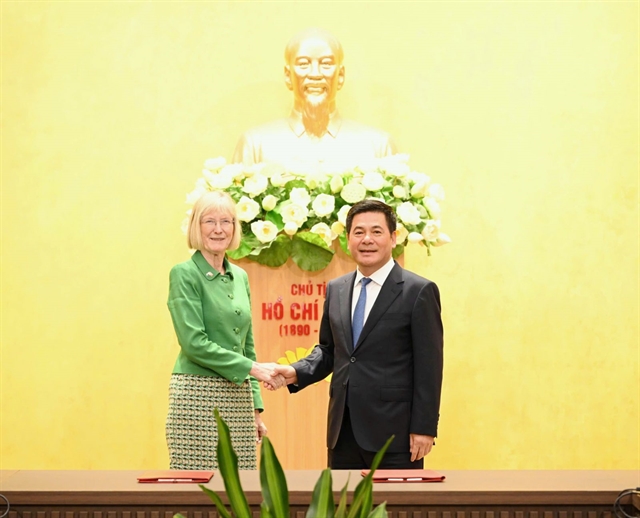 Sunday/Weekend
Sunday/Weekend

Whenever I think of coconuts, Bến Tre Province immediately comes to mind.
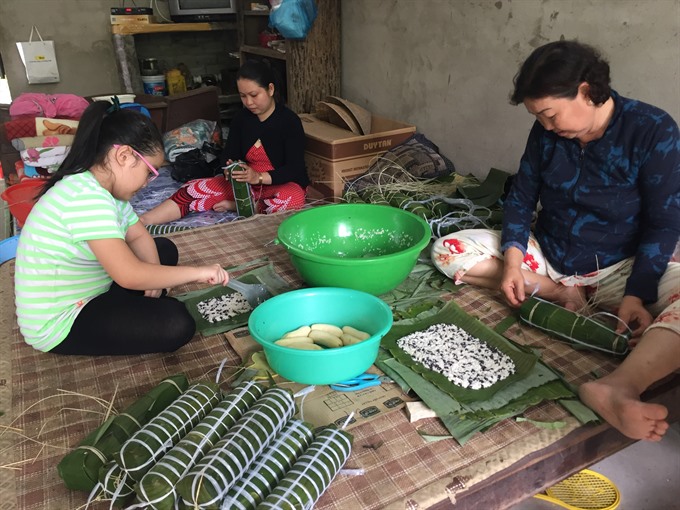 |
| Talented: Nguyễn Bạch Lan, also known as Má Bảy (Seventh Mum) from Bến Tre‘s Châu Thành District, often uses coconut to make dishes, including cakes for her family. – VNS Photo Văn Châu |
Coconuts can be found anywhere and everywhere in Việt Nam. The fruit’s versatility is renowned. Juice, candy, rice and meat dishes are all immensely popular, but only in the Mekong Delta province of Bến Tre can you find the Green Xiêm coconut. It’s so special that it was recently granted a certificate of Geographical Indication.
Văn Châu
BẾN TRE – Whenever I think of coconuts, Bến Tre Province immediately comes to mind.
Though coconut trees can be found nearly everywhere in the country, only in Bến Tre can you find the special species of palm tree that is characteristic of the region.
Located in the southwestern part of the Mekong Delta, about 90km west of HCM City, Bến Tre has long been famed for its delicious variety of coconut dishes.
Travelling from HCM City, you will soon notice the shadows of coconut trees as you cross the Rạch Miễu Bridge over the Tiền River linking the two Delta provinces of Tiền Giang and Bến Tre.
All around you are lush, verdant paddy fields and boats quietly gliding on waterways, a perfect gateway to a relaxing vacation or weekend retreat away from the big city.
One of the area’s most famous products is kẹo dừa (coconut candy), a favourite treat of southerners, closely followed by banana candy. The two traditional candies originated in Bến Tre.
Twenty to 25 years ago, when Việt Nam had not integrated with the world, coconut candy production was limited. Made simply with only coconut milk and sugar, it was mostly for domestic use only.
But now, coconut candy makers have added durian and pandan leaf, and even roasted peanuts, to their products which are sold both in Việt Nam and abroad.
However, when it comes to coconut candy, I’m a purist since I have pleasant memories of the taste when I was a child. The durian flavour, to me, is so strong I can’t tell if I am eating durian or coconut!
However, peanuts and coconuts are a fine combination. In the past, the outside paper would often stick to the candy, but now the makers double-wrap the candy, with edible rice paper and an oily paper on the outside. Problem solved.
The candy, one of the most traditional items in the Mekong Delta, is so common here that many tourists can easily find workshops to view the processing and making of coconut products.
Bến Tre authorities are well aware of the revenue that such handcrafted candies and cakes can bring to locals. They have maintained the working culture and tradition, and have promoted tourism activities to attract more visitors.
Although today you can buy Bến Tre candy anywhere in the province, the product first appeared sometime before the 1960s in Bến Tre’s Mỏ Cày District.
Called Mỏ Cày candy, it included sugar, coconut milk and malt, skillfully mixed in the pan by stirring. The maker did not use any kind of mold, and the mixture was chopped up into small cubes and wrapped.
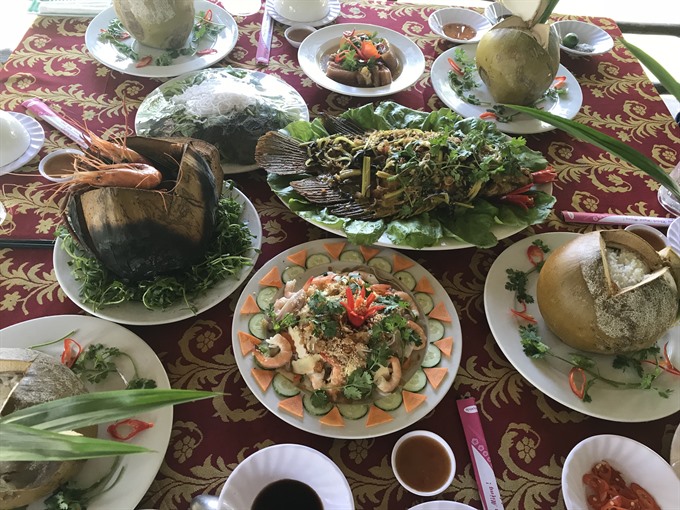 |
| Versatile: Bến Tre people use coconut meat and juice in many of their dishes. VNS Photo Văn Châu. |
Coconut rice
Coconut rice is also a popular dish in Bến Tre. Instead of water, cooks use coconut juice to steam the rice.
After washing and drying the rice, cooks cut the top of the coconut to let the water out. The hardest part is to measure the right amount of coconut juice. If there is too much, the rice will be wet, and if there is too little, the rice will be dry.
It’s best to eat it hot because if the rice is left out too long, it will turn yellow.
Võ Văn Trọn, 42, who has been cooking coconut delicacies for12 years, said the cooking method was easy.
“But you must use the Green Xiêm coconut from Bến Tre. It has a distinctive and recognizable appearance. The fruit and shell is small and the water inside is sweeter than coconuts cultivated in other regions.”
Coconut juice from the province’s Green Xiêm variety, which received a certificate of Geographical Indication in March from the National Office of Intellectual Property, is also used as a refreshing drink and health enhancer.
“The quality of Green Xiêm coconut is different from others’ in terms of nutritional content.” Trọn said. “No delicacy is better than to eat coconut rice with roasted shrimp braised with coconut milk.”
Trọn uses all kinds of shrimp, which turn beautifully red after roasting.
After washing the shrimp, he marinates them with salt and sugar for half an hour. He then squeezes the milk from the dried coconut and pours the liquid on the shrimp, and roasts until the milk caramelises. To make the shrimp shine, he adds a bit of cooking oil.
“Bến Tre people use coconuts in most of their local foods, even in the traditional caramelized pork with eggs and sticky rice cakes. In the past, the specialties were prepared for Tết (Luna New Year) or anniversary days of the family. However, they’re now eaten as part of daily meals of any household,” Trọn said.
In areas of the country where coconuts are not plentiful, people often cook the dish with a lot of spices and sugar caramel, instead of caramel made of fresh coconut water, which is not as tasty, according to Trọn.
“Making caramelised pork Bến Tre style is simple. It is just pork, fresh coconut water and a little sugar. If you want some heat, add chillis to the marinade,” he said.
Trọn mixes the pork with a little sugar to make the pork fat glassy-clear after it is cooked, and then exposes the meat to the sun for 30 to 45 minutes to make the skin billow out. Then he slowly cooks the pork with coconut water until it is done.
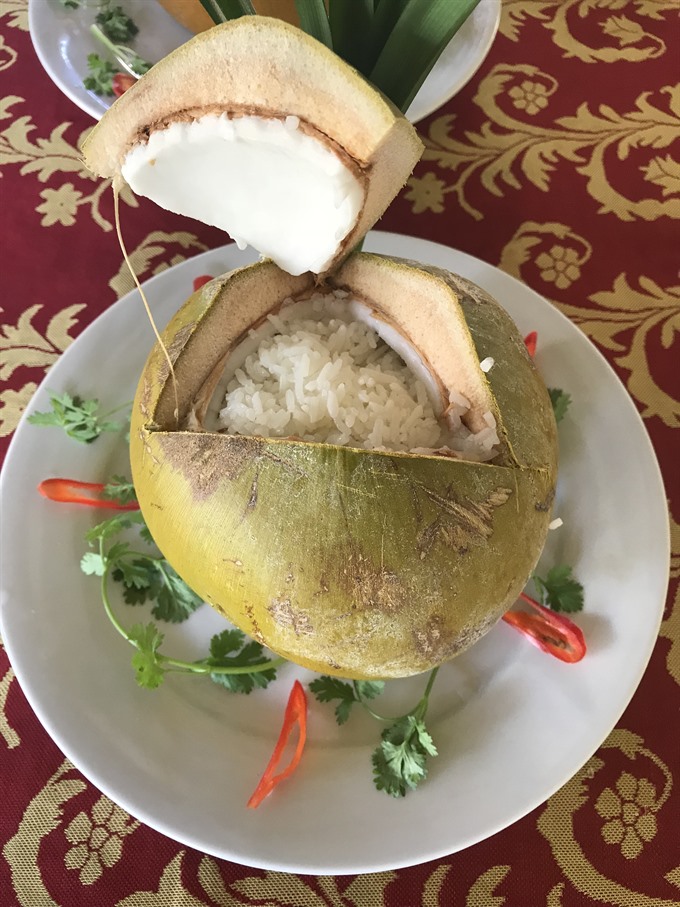 |
| Treat: Coconut rice cooked inside a Green Xiêm coconut, a special variety that has received a certificate of Geographical Indication from the government. – VNS Photo Văn Châu |
“My cooking method makes the pork and sauce turn an eye-catching brown colour, and the taste is unique and irresistible,” he said.
Nguyễn Bạch Lan, also known as Má Bảy, from Bến Tre‘s Châu Thành District, is another well-respected cook in the province.
She often makes coconut rice cakes for her family.
“My traditional sticky rice cake would not be delicious or aromatic at all without coconut,” she said.
“As you know, we use all parts of the coconut tree in our daily work: the tree and shell for cooking food and making handicrafts, and the leaves for building houses and wrapping the famous sticky rice cakes called bánh Tét lá dừa.
“We also use coconut milk for local traditional sweet cakes, candies, hot dishes and cold sweet soups. Coconut juice is used to make drinks or caramelised sauce, and we also make candied coconut ribbons," Lan said.
Annually, Bến Tre harvests 600 million of coconuts cultivated on 70,000ha of land.
The fruit is the key income of local residents. However, due to severe drought and salinity in 2016, the output dropped by 20-30 per cent last year. Local coconut processing companies at that time had to import coconut materials for production.
However, with the new Geographical Indication certification from the government, the province expects Green Xiêm exports to increase, especially in the US, the EU and Japan, and the price to rise in the domestic market.
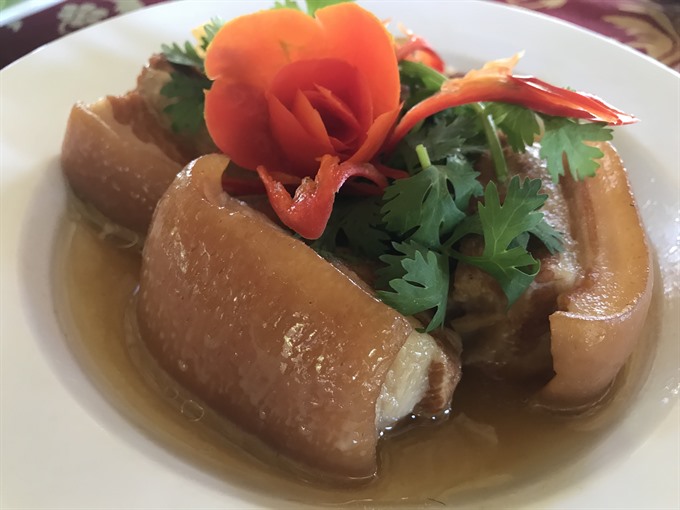 |
| Delicious: Traditional caramelised pork sauce turns an eye-catching brown when cooked with fresh coconut water. – VNS Photo Văn Châu |
Bird sanctuary
Aside from sampling coconut products, visitors to the province can also explore the Vàm Hồ Bird Sanctuary and ecotourism activities on Phụng (Phoenix) Islet. The sanctuary is located in Ba Tri District which is 52km east of Bến Tre Township.
The spectacular site is home to wild forests with a great variety of trees, including water coconuts, dates, mangrove trees and reeds. It is a favourite destination for 84 species of birds, including around 500,000 storks.
The best time to see the storks is April to October when they come to Vàm Hồ to lay eggs and raise their young. Though the birds can be seen during the day, the most exciting time to watch them is at sunset when thousands of storks fly over the Ba Lai River under a glowing sky over the forest.
Inside the bird sanctuary, visitors can travel by boat in the submerged forest and walk on narrow bamboo bridges in the well-preserved wetlands.
Of course, the perfect capper to an all-day tour would be a cool Bến Tre coconut drink, a few coconut rice cakes, and a dish of caramelised shimp or pork! — VNS

